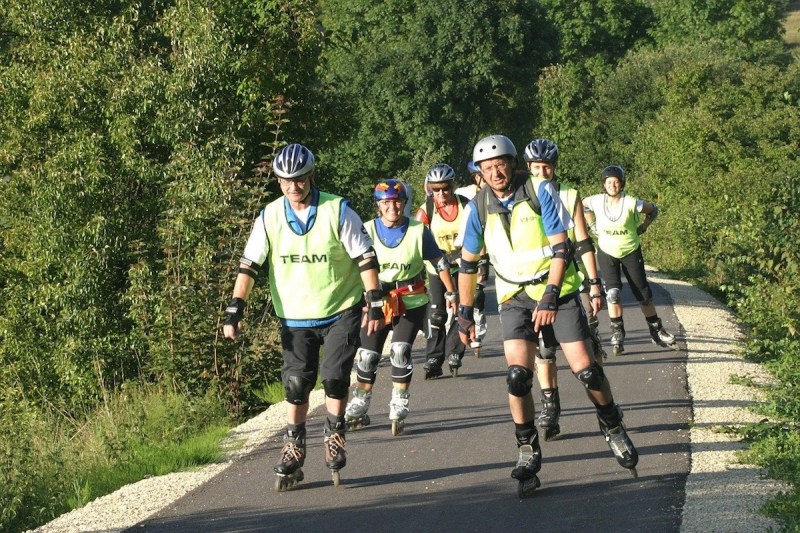Picture yourself running, cycling, swimming, using a rowing machine or elliptical, hiking, or walking. While the specific movements involved in any of these types of exercises are indeed different, all of the movement patterns have something in common: They involve getting from Point A to Point B in a forward direction. While this may not sound novel nor important, the fact that we train our bodies nearly exclusively in a forward and backward direction, in a plane of motion known as the sagittal plane, is actually somewhat problematic. Focusing solely on forward and back movements can create muscle imbalances and neglect critical stabilizing muscles, increasing your risk of musculoskeletal injury and limiting your overall athletic performance potential.
Lateral training can be seen as the antidote to this common exercise training pitfall. As the name suggests, lateral training involves side-to-side exercises and is an important — yet often overlooked — component of a well-rounded training program. While you might be incorporating a few lateral training exercises into your workout routine, chances as your overall movement patterns and strengthening exercises are imbalanced, as the focus on the importance of lateral training is still in its nascent stages. Keep reading for our guide to lateral training and get ready to use new muscles and shake up your workout routine.

What is Lateral Training?
Lateral training involves performing exercises that have a side-to-side movement pattern, or include motions that occur in what is known as the frontal plane. For example, a side lunge, in which you separate your legs and step one out to the side and then load that leg by bending your knee and leaning into the leg, is a lateral exercise, while a forward lunge is not.
What Are the Benefits of Lateral Training?
As mentioned, because the majority of our movements and attention are directed forward both in fitness and daily life, many workout programs and exercises focus on the forward and backward directions only. As a result, we routinely build strength in large muscle groups like the glutes, quads, hamstrings, and calves.
However, because we train these muscles extensively, we end up relying on them to the detriment of smaller stabilizing muscles responsible for lateral movements, such as the hip abductors, like gluteus medius, and hip stabilizers an external rotators like the piriformis, gemellus superior, and gemellus inferior. As a result, these stabilizing muscles get weaker and weaker, which can increase your risk of injury because they may eventually lack adequate strength to support yourself should you suddenly make a lateral movement or load your body in a lateral direction.
Thus, the primary benefits of lateral training include its ability to correct muscle imbalances, restore optimal movement patterns, and reduce the risk of musculoskeletal injuries. Lateral training also improves your flexibility, balance, core strength, and body awareness.
Do I Need to Do Lateral Training?
A common misconception is that lateral training is only important for athletes competing in sports with lateral movements such as soccer, tennis, volleyball, basketball, football, and baseball. However, lateral training is equally important for athletes who participate or complete in endurance sports with forward movements, such as running, swimming, rowing, cycling, and triathlon, and everyday individuals just trying to stay fit.
While athletes competing in contact sports or sports with a high degree of lateral agility may need to place a greater training emphasis on lateral exercises, everyone should incorporate lateral training into their workout routine to prevent muscular imbalances and resultant injuries.
Exercise Equipment for Lateral Training
For the most part, the same exercise equipment you would use for standard strength training exercises, such as dumbbells, kettlebells, resistance bands, and medicine balls, can be used for lateral training exercises. There are also additional pieces of specialized exercise equipment designed to facilitate lateral training exercises, namely slide boards and gliding discs for your feet.
A slide board is a thin, slick board that is used with special, smooth booties to eliminate friction, and create an environment somewhat akin to ice. The slide board has bumpers on either end so that various exercises like speed skating side to side can be performed.
The Brrrn Board

When it comes to buying a slide board for home use, we recommend the Brrrn Board, due to its superior construction, portability, ease of use, customer support, and accompanying exercise guidance. The Brrrn Board has been used as a cross-training tool by athletes across all sports for decades, including celebrated U.S. winter athlete and Brrrn investor, Apolo Ohno. It can be used for strengthening exercises as well as cardio and core workouts, all of which can be found on their website and app.
Examples of Lateral Training Exercises
The following are examples of effective lateral training exercises that will strengthen a variety of stabilizing muscles in your lower body, core, or upper body:
- Side lunges
- Slide board speed skaters
- Clam shells
- Resistance band side steps
- Side planks with leg raises
- Planks with arms slides
- Spider-Man push-ups
- Lateral hops
- Lateral crab walks
- Lateral step ups
- Side shuffles
- Agility ladder drills
- Lateral crossover walks and runs
- Zig-zag running drills
- Side-lying leg raises
- Medicine ball chops
- Rollerblading
How Often Should You Incorporate Lateral Training Into Your Workout Routine?
Ideally, lateral training should be incorporated into all of your workouts to some extent, regardless of your primary sport, fitness goal, age, or
Like other forms of training — cardio, core training, balance work, strength training, etc. — some form of lateral training should be a component of your workout but variety is key; some days, lateral training can be the focus, while other days, it can be more nuanced. Similarly, some workouts may involve lateral cardio exercises on a slide board, whereas others can involve lateral strength exercises like side lunges.



